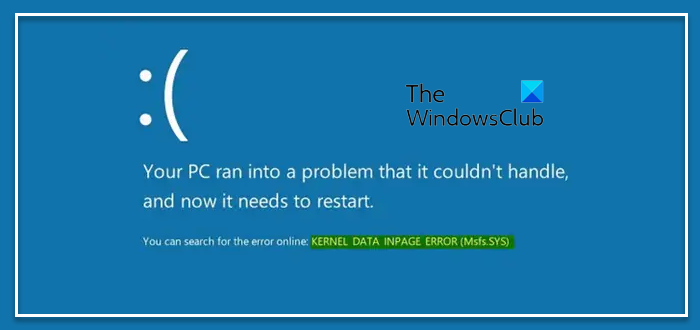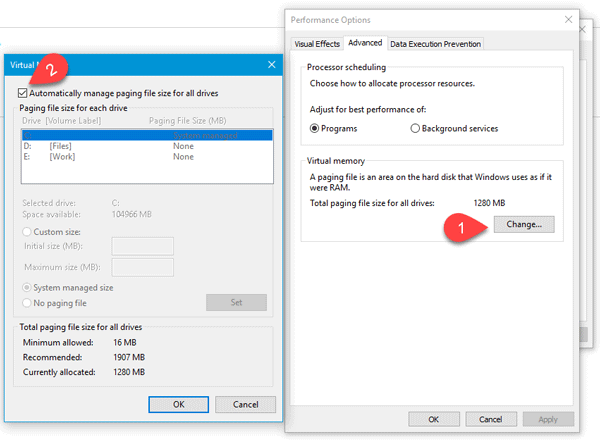In this post, we will show you how to fix KERNEL_DATA_INPAGE_ERROR Blue Screen caused due to Msfs.sys, win32kfull.sys, ntfs.sys, srv.sys drivers with errors 0xC000009C, 0x0000007A, 0xC000016A.

This Blue Screen indicates that the requested page of kernel data from the paging file could not be read into memory. If you have encountered this BSOD error when you try to wake up or start up your Windows 11/10 device, you can try the solutions presented in this post.
What causes KERNEL DATA INPAGE ERROR?
The typical causes could relate to Memory, Paging file corruption, File system, Hard drive, Cabling, Virus infection, Improperly seated cards, BIOS, Bad motherboard, and Missing Service Pack. If there is some internal problem with your RAM or the RAM is faulty, the hard drive has bad sectors, the page file is damaged, drivers are outdated or incompatible, etc., then such an error may occur. At such times, the Blue Screen will display a message:
Your PC ran into a problem that couldn’t be handle, and now it needs to restart. You can search for the error online: KERNEL DATA INPAGE ERROR (Msis.SYS)
This error could specifically point to Msfs.sys, win32kfull.sys, ntfs.sys (NT File System driver file is a Windows driver) or srv.sys (Server drive file is a Windows driver) files.
Fix KERNEL DATA INPAGE ERROR in Windows 11/10
If a file name – eg, Msfs.sys is mentioned, it means that this driver gave problems. Now, if a computer restart doesn’t now fix this issue, you may follow these suggestions and see if they help you fix the problem.
- Run Memory Diagnostics
- Search for hard drive corruption
- Update or Rollback the concerned driver
- Automatically manage paging file size
- Uninstall recently installed hardware/software
- Run Blue Screen Online Troubleshooter
- Run CHKDSK
- Troubleshoot in Clean Boot State.
1] Use Windows Memory Diagnostic

If you have started getting this error message suddenly, it might be occurring because of some internal issues with your hard drive or RAM. Run Windows Memory Diagnostic Tool – it will let you detect problems and try to fix them automatically. To start this tool, search for mdsched.exe, right-click on the search result, and select Run as administrator. After opening the Windows Memory Diagnostic window, you need to click on Restart now and check for problems option.
2] Search for hard drive corruption
A bad sector on the hard drive can cause this problem. If you want to search for possible hard drive corruption, there is a Chkdsk command that can help you. Open Command Prompt with administrator privilege and enter this command.
chkdsk /f /r
The OS will run the Disk Checking Utility on ALL hard drives and fix and repair the bad blocks or sectors.
3] Install/UpdateRollback drivers
If your motherboard came with a driver CD/DVD, you would find all the essential drivers that you need to install on it. You should install all the drivers from that CD. If you don’t have it, you may use a good driver updater software to download, install or update all your device drivers. You may make use of Intel Driver Update Utility or AMD Driver AutoDetect.
If a driver name is mentioned, rollback or update that particular driver.
4] Automatically manage paging file size

This error message can appear because of a bad sector in the paging file. What you need to do is open This PC, right-click on space and select Properties. On your left-hand side, you should get Advanced system settings. Click on it, switch to the Advanced tab and click on Settings under Performance tag. Again switch to the Advanced tab in the Performance Options window. Now you need to click on the Change button under Virtual memory. Finally, make sure the Automatically manage paging file size for all drives check box is selected and save your settings.
5] Uninstall recently installed hardware/software
If you have recently installed any hardware such as printer/scanner, webcam, external hard disk or software, uninstall it. Sometimes a device driver may not be compatible with Windows 11/10, and hence users can get such error messages on their monitor. To do this open Devices Manager, identify the hardware, right-click on it and select Uninstall.
6] Run Blue Screen Online Troubleshooter
We always recommend you first run the Blue Screen Online Troubleshooter from Microsoft to attempt to fix BSOD errors you may encounter on your Windows 10 device.
7] Run CHKDSK
CHKDSK is a viable solution that could fix this error.
To run CHKDSK, do the following:
- Press Windows key + R to invoke the Run dialog.
- In the Run dialog box, type cmd and then press CTRL + SHIFT + ENTER to open Command Prompt in admin/elevated mode.
- In the command prompt window, type the command below and hit Enter.
chkdsk /x /f /r
You will receive the following message:
CHKDSK cannot run because the volume is in use by another process. Would you like to schedule this volume to be checked the next time the system restarts? (Y/N).
- Tap Y key on the keyboard and then reboot your computer.
After CHKDSK completes, check to see if the issue is resolved. If not, try the next solution.
8] Troubleshoot in Clean Boot State
If the problem is occurring because of any 3rd-party driver, you will be able to detect it by performing a Clean Boot, and then manually identifying the offender. You need to disable all the third-party services and restart the PC with only Microsoft services.
I hope something here helps you.
Read: How to find which Driver is causing the Blue Screen on Windows?
How do I fix Kernel Security Check?
If you encounter a Kernel Security Check Failure error on your Windows PC, then use the System File Checker tool to fix the corrupt or missing system files. If that doesn’t solve the problem, scan your hard disk for errors, run the Driver Verifier Manager to verify unsigned drivers, specified drivers, etc., and use the Memory Diagnostic Tool to fix the error. You might also have to Troubleshoot in Clean Boot State to identify the culprit application and remove it from your system.